Francois Castaing, on taking over Chrysler Engineering, found trucks powered by a V6 and two V8s whose basic design went back to the 1951 Hemi. He set up a team to replace the smaller V8 and the V6, resulting in the 3.7 and 4.7 V8s. He then asked the same team to replace the remaining V8, the 360. Rather than simply stroke the 4.7, this team chose to create a brand new engine, the 5.7 Hemi. It was much more powerful than a bigger 4.7 would have been.

Another team started working on an all-out performance version of this new Hemi, to displace 6.1 liters. It had a 3.5 mm larger bore, honed with torque plates to be perfectly shaped.
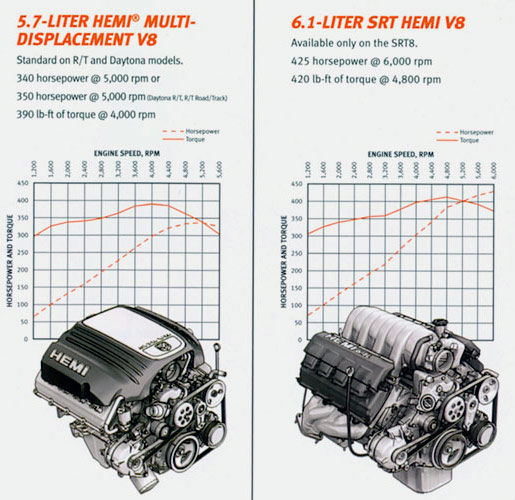
When it reached production, the 6.1 was something of a sensation. Its horsepower rating matched the gross (brake) horsepower of the old 426 Hemi; but the net power of the 426 was much lower. The 426 was also known for drinking oil—its rings were deliberately undersized, letting more oil through, but reducing friction; this engine was not. In addition, owners never needed to adjust the carburetor or ignition timing.

The engine debuted in the 2005 Magnum and 300C, spanning the Dodge and Chrysler marques; all had the SRT-8 badge as well. The blocks were painted orange; the valve covers were black and spelled out the Hemi name and the displacement. Later the engine moved to the 2006 Dodge Charger, then the 2007 Grand Cherokee, and finally the 2008 Dodge Challenger. In the Charger, the 6.1 provided 0-60 times, with an automatic, in the “low-five-seconds range”—better than the stock 426 Hemi. SRT’s trademark 0-100-0 mph run came in the mid-16-second range.
The 2008 Challenger SRT-8, which was also available with a Tremec six-speed manual transmission, registered 0-60 mph in 4.9 seconds, the quarter mile in 13.3, and the 0-100-0 run in under 17 seconds. The Tremec TR-6060 was similar to the one in the Viper and Corvette. It cost just under $38,000.
Curtis Redgap wrote for Allpar, concerning the Magnum, “The big engine churned up instantly with no hesitation at all. Settling down, it was idling at about 750 rpm shown on the dash tach. As such, it was hush quiet... though cranking out the bass when accelerating. Acceleration is quick, without fanfare, and much easier to handle than you can imagine.
“I lit up the tires, backed off, catch the traction control, and laid into it again. The traction control program caught up to itself at about 45 miles an hour, then it set me straight back into the seat. It was just delightful power! The intake was at full song, and the exhaust system sounded like a snare drummer stuck on a bass drum using axe handles to make the noise. It was thrilling to say the least.”
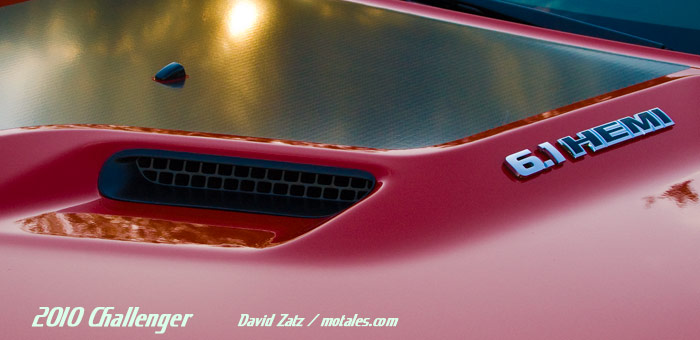
After driving the 2008 Charger SRT-8, I wrote, “Acceleration is strong but not always predictable, with a transmission that is sometimes slow to shift and doesn't kick down as rapidly as the high-revving engine would like. The engine makes decent enough power in low rpms, but really comes into its own at higher engine speeds, with a full-bore roar.”
Jim Choate wrote, “Motoring between the test track and the handling track, I was very pleased with how the SRT-8 moved at normal speeds. I've driven some powerful cars where they were fun as long as you were at speed, once you dropped below 40 or so, they ran poorly and weren’t fun. Not so in this car.
“The 6.1 Hemi roars loudly into life and has a fairly loud, deep note, making it clear that it means business. Inside the Charger, ... the rumble isn't overpowering and the engine is quiet at idle and high speed. Acceleration comes immediately; then the transmission downshifts, and the Charger shoots forward.”
New externally-damped valve springs allowed engine speed to run past the 5.7’s 5,400 rpm redline to 6,200 rpm; now, peak output came at 6,000 rpm rather than at 5,000 rpm. The billet steel camshaft had more overlap and lift than the 5.7; the intake valves were larger as well, and the fuel injectors has higher flow rates. Valve springs were beehive types, chosen for their light weight.
The intake and exhaust manifolds were new, along with the air cleaner box and resonator; the cast aluminum intake had large, tapered runners, core-dipped to smooth the internal finish. The exhaust was 2.75 inches in diameter rather than 2.5 inches for the 5.7, and had 3.5-inch chrome tips.
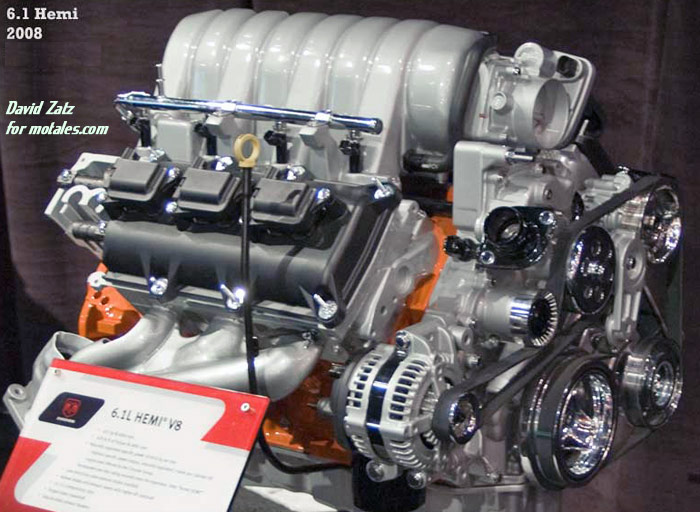
Lke the truck engine, the 6.1 SRT engine had no cylinder deactivation. It took premium fuel to enable the higher compression (raised from the 5.7’s 9.6:1 to 10:3:1), and more aggressive timing. The only transmission on the Charger and 300C was the A580 five-speed automatic; the Challenger had a manual transmission option.
The exhaust headers were individual tubes encased in a stainless steel shell. Exhaust runners provided more gas flow while keeping fast catalyst light-off; the new manifolds were good for 12 horsepower over the 5.7-liter engine’s cast manifolds, while the intake changes added 14 horsepower on their own.
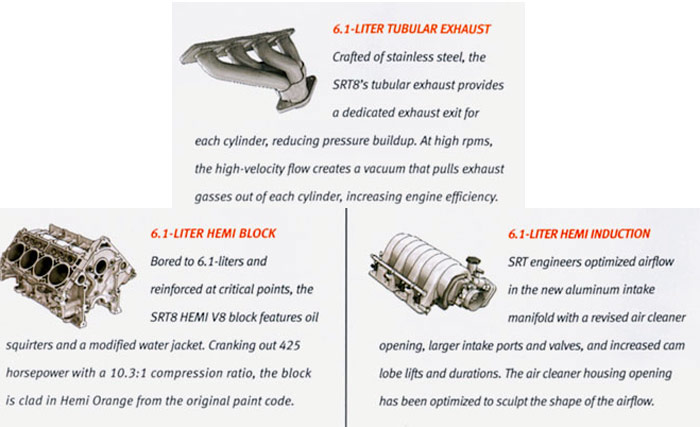
SRT demanded that engines to work well when raced, and that power stay steady even under high demand for a long period; that meant better than normal cooling and durability, requiring many other changes to the 5.7 design. These included:
As with the 5.7, the SRT engine used twin spark plugs for each cylinder; to cut the number of coil packs in half, each cylinder had a coil pack over one spark plug; the other plug was wired to another cylinder on the opposite bank. The extra plug fired during the power stroke to get to any unburned hydrocarbons, also reducing oxides of nitrogen and ozone.
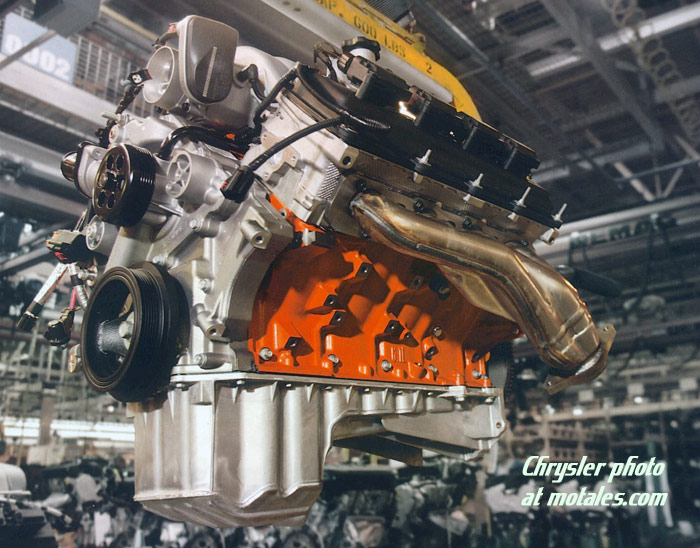
As this was a Chrysler product, they used speed density rather than air mass measurements for the computer. As it was a Hemi, like the original, it had twin rocker shafts for each cylinder (to avoid having dual cams), large valves similar in size to the 392, and two valves per cylinder—not the fashionable four—arranged in the same way as past Hemi valves.
The electronic throttle control system automatically changed the idle speed to deal with the air conditioning, alternator, power steering pump, and cruise control.
Displacement |
370 cu. in. (6059 cc) |
Bore x Stroke |
4.06 x 3.58 (103.0 x 90.9) |
Compression Ratio |
10.3:1 |
Power |
425 bhp @ 6200 rpm |
Torque |
420 lb.-ft. @ 4800 rpm |
Redline |
6400 rpm |
Fuel |
91 octane (premium) |
Oil Capacity |
7 qt. (6.6L) |
Coolant Capacity |
14 quarts (13.25L) |
Max Trailer Weight |
Don’t tow! |
Fuel Economy |
14 city/19 highway |
Information from press books, Motales, and Mopar Action.
See other engines at Motales! • All Mopar V8s
Copyright © 2021-2025 Zatz LLC • Chrysler / Mopar car stories and history.
YouTube • Editorial Guidelines • Videos
Tailfins Archive • MoTales on BlueSky